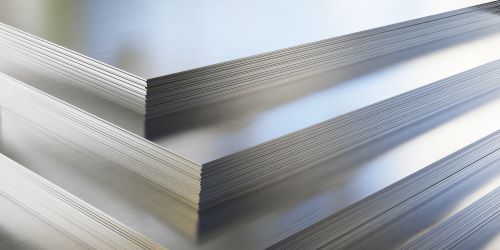Aluminum and stainless steel are two metals that are commonly used in a wide variety of applications. While the list of benefits of each is quite long, there are two key reasons why they’re so popular: They are both naturally resistant to corrosion and easily fabricated into just about any shape. Let’s examine how they compare to each other in terms of strength, electrical conductivity, thermal properties, machinability, and cost.
Strength
Stainless steel is heavier and stronger than aluminum and is, therefore, often used in structural components and architectural features of buildings. And because it naturally resists corrosion, stainless steel is the go-to material for commercial food and beverage processing equipment, home appliances, petrochemical refinement equipment, and marine applications.
Though lighter and less strong than stainless steel, aluminum has a better strength-to-weight ratio. This makes it ideal for use in automotive and aerospace applications, as it can help increase the load capacity and fuel efficiency of vehicles and aircraft.
Electrical Conductivity
When it comes to conducting electricity, aluminum is far better than stainless steel. This is why it is widely used in power lines, wiring, and other electrical system components. Aluminum is also a better thermal conductor than stainless steel and is the material of choice in rapid-cooling applications, such as in air conditioning units, LED lights, and radiators.
Thermal Properties
While aluminum is a better thermal conductor, the strength of stainless steel allows it to withstand higher temperatures. In fact, stainless steel can hold its own in extreme temperatures of over 400 degrees Celsius (about 750 degrees Fahrenheit), whereas aluminum begins to soften around 200 degrees Celsius (just under 400 degrees Fahrenheit). For heavy industrial applications in intense-heat environments, stainless steel is the preferred choice.
Machinability
Aluminum’s high thermal conductivity and low melting point can make it a challenge to fabricate, especially compared to stainless steel, whose inherent malleability makes fabricating relatively easy. Of course, CNC plasma cutting tables can make short work of either material, which is why they are a favorite tool of custom fabricators.
Cost
Apples to apples, aluminum comes with a higher price tag—up to 30% higher—than stainless steel. The stark price difference is caused by a variety of factors, including fuel prices and accessibility of raw ore. However, because aluminum has a higher strength-to-weight ratio than stainless steel, less of it is needed in applications where either material can be used, which can actually result in lower overall costs.
CNC Plasma Cutting Tables for Fabricating Aluminum & Stainless Steel
Aluminum and stainless steel are two popular materials that custom metal fabricators are used to working with. As mentioned above, professional fabricators will often utilize CNC plasma cutting machines to automate, perfect, and speed up their production of aluminum and stainless steel fabrication. And when they need state-of-the-art CNC plasma cutters to improve operations at their shops, professional fabricators turn to Machitech.
Our heavy-duty CNC plasma cutting solutions are fully customizable to meet a variety of needs, and they include free and unlimited support for life. To learn more, contact Machitech today.
 English
English  Français
Français 
